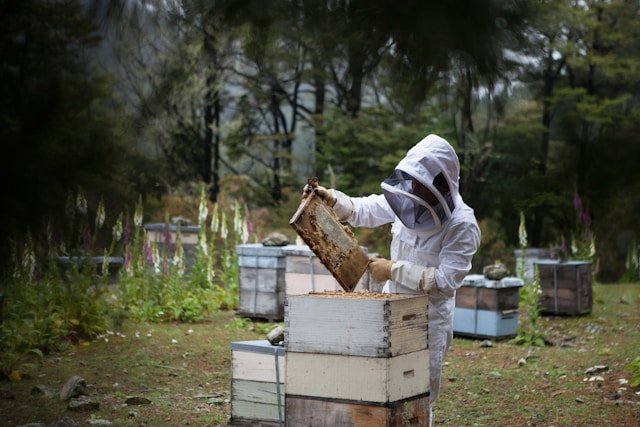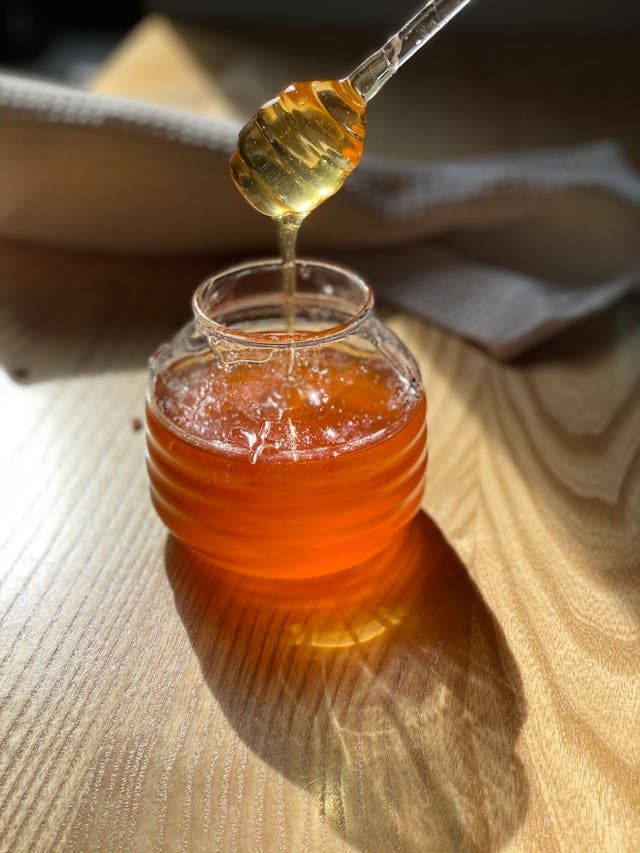Imagine trekking through the dense Amazon rainforest, the air buzzing with life. Despite the castle and vibrant wildlife, you walk upon a local beekeeper tending to his hives. He offers you a taste of the honey. When you savor the rich, floral sweetness, you realize this is unlike any honey it’s ever tasted. This is the unique feature of South American honey with the product of the region’s biodiversity and centuries-old traditions.
South America, is a continent of vast and varied landscapes and is also home to a diversity of honey. From the wildflower honey of the Andean highlands to the eucalyptus honey of Brazil. Each type reflects the unique flora and ecosystem of its origin. This natural magic and both traditional and modern beekeeping practices result in a various array of honey varieties. Each type has a distinct flavor profile and beneficial properties.
This blog post aims to explore the unique characteristics of the different types and the health benefits of South American honey. We will also look at the cultural importance of honey in South American societies. I have a plan to highlight its role in culinary traditions, and medicinal practices. By the end of this journey, you will have a deeper sense of this sweet treasure and a better understanding of why South American honey is really special.
Types of Honey: Introduce the different types of honey produced in South America
Amazon Rainforest Honey: The Treasure of Brazil Amazon Rainforest Honey, often referred to as the “liquid gold” of Brazil. The honey is a unique and high prized that stands out for its rare flavor, nutritional benefits, and ecological significance. Harvested from the heart of the Amazon rainforest, this honey express the rich biodiversity of one of the world’s ecosystems.
The Unique Characteristics of Amazon Rainforest Honey
1. Floral Diversity:
o The Amazon rainforest is home to an unparalleled variety of plant species, many of which are endemic to the region. This floral diversity contributes to the exceptional flavor profile of the honey. It also offers a blend of sweet, floral, and sometimes slightly spicy notes.
2. Nutrient-Rich:
o Amazon Rainforest Honey is packed with vitamins, minerals, and antioxidants. It contains higher levels of vitamins C and B, iron, and magnesium compared to other types of honey. These nutrients help boost the immune system, improve digestion, and promote overall health.
3. Medicinal Properties:
o Traditional Amazonian medicine has long revered this honey for its therapeutic properties. It is known for its antibacterial and anti-inflammatory effects. For this reason, it is an excellent natural remedy for wounds, sore throats, and digestive issues. Sustainable Harvesting Practices
1. Eco-Friendly Methods:
o The harvesting process of this honey uses eco-friendly practices that ensure minimum disturbance to the environment. Beekeepers often follow traditional methods that have been passed down through generations. It emphasizes the importance of preserving the natural habitat of the bees. It can emphasize the importance of preserving the natural habitat of the bees.
o Many beekeepers in the Amazon are part of indigenous and local communities. The production of rainforest honey provides them with a source of income. It is also supporting their livelihoods while promoting the conservation of the rainforest.
2. Conservation Efforts:
o When someone wants to purchase Amazon Rainforest Honey, they are contributing to the conservation of the Amazon rainforest. The lifecycle process of honey production helps protect the rainforest from deforestation. It also promotes the preservation of its biodiversity. Culinary Uses
1. Gourmet Ingredient:
o Amazon Rainforest Honey is a favorite among chefs and food enthusiasts for its unique flavor. It can be used as a sweetener in teas, desserts, and sauces, or as a flavorful addition to marinades and dressings.
2. Pairings:
o The complex taste of this honey pairs well with a variety of foods, including cheeses, fruits, and nuts. It can also enhance the flavor of savory dishes, adding a subtle sweetness that complements spices and herbs. Eucalyptus Honey: The Pride of Argentina Eucalyptus Honey, a typical and flavorful variety from Argentina. It is popular for its unique taste, health benefits, and the practices associated with its production. This honey is usually sourced from the nectar of eucalyptus trees. It offers a refreshing and medicinal quality that sets it apart from other types of honey.
The Unique Characteristics of Eucalyptus Honey
1. Distinctive Flavor:
o Eucalyptus Honey has a robust, slightly medicinal flavor with a hint of menthol. This unique taste profile is a result of the nectar from eucalyptus flowers, making it a favorite among those who enjoy bold flavors.
2. Rich in Nutrients:
o This honey is rich in essential nutrients, including vitamins B and C, calcium, and iron. These nutrients contribute to its health benefits, making it a nutritious addition to any diet.
3. Therapeutic Properties:
o Eucalyptus Honey is celebrated for its therapeutic properties. It has strong antibacterial and antifungal effects. For this reason, it can be used as a natural remedy for respiratory issues, sore throats, and wound healing. Its slight menthol flavor also provides a soothing effect on the throat. Sustainable Harvesting Practices
1. Eco-Friendly Production:
o Beekeepers in Argentina employ sustainable practices to harvest eucalyptus honey. These methods ensure that the natural habitats of the bees are preserved but the environment remains well. The beekeeping process often involves minimal intervention, allowing bees to thrive naturally.
2. Supporting Local Economies:
o The production of eucalyptus honey supports local farmers and beekeepers providing a source of income. This economic support is important for rural people in Argentina. It helps them to promote continuous development.
3. Environmental Conservation:
o By maintaining eucalyptus plantations and practicing sustainable beekeeping, producers contribute to environmental conservation. Eucalyptus trees play a important role to protect environment. In this way, it helps combat climate change and land degradation.
Culinary Uses
1. Versatile Ingredient:
o Eucalyptus Honey’s distinctive flavor makes it a versatile ingredient in the kitchen. It can be used to sweeten teas, enhance the flavor of baked goods, or add a unique twist to savory dishes and marinades.
2. Flavor Pairings:
o The bold taste of eucalyptus honey pairs well with a variety of foods, including cheese, nuts, and citrus fruits. It can be drizzled over yogurt or oatmeal for a refreshing breakfast, or used to glaze meats for a flavorful main course. Tawari Honey: The Jewel of Chile Tawari Honey, a different variety from Chile. It is renowned for its flavor, health benefits, and the sustainable practices that correlated its production. The honey is derived from the nectar of the Tawari tree flowers and offers a unique taste and numerous health advantages. It is a prized product among other types of honey.
The Unique Characteristics of Tawari Honey
1. Delicate Flavor:
o Tawari Honey is known for its smooth, mild flavor with subtle floral undertones. This gentle sweetness makes it a favorite for those who prefer a more delicate taste in their honey.
2. Nutrient-Dense:
o Tawari Honey is rich in essential nutrients such as vitamins B and C, amino acids, and minerals like potassium and magnesium. These nutrients contribute to its numerous health benefits, supporting overall well-being.
3. Medicinal Properties:
o This honey is known for its medicinal properties, including anti-inflammatory, antibacterial, and antioxidant effects. It is often used as a natural remedy for soothing sore throats, promoting digestive health, and enhancing skin care. Sustainable Harvesting Practices
1. Eco-Friendly Methods:
o Chilean beekeepers employ sustainable and eco-friendly practices to harvest Tawari Honey. These methods add minimal response in natural bee habitats and the use of basic techniques that respect the environment.
2. Supporting Local Communities:
o The production of Tawari Honey supports local farmers and indigenous communities in Chile. This economic support helps to maintain their livelihoods. It also promotes the preservation of basic beekeeping practices.
3. Conservation Efforts:
o By maintaining Tawari tree populations and practicing beekeeping, producers contribute to environmental conservation. The Tawari tree plays a role in local ecosystems, supporting biodiversity and protecting against wasting of soil.
Culinary Uses
1. Versatile Ingredient:
o Tawari Honey’s delicate flavor makes it a versatile ingredient in the kitchen. It can be used to sweeten beverages, enhance the flavor of desserts, or add a subtle sweetness to savory dishes.
2. Flavor Pairings:
o The mild taste of Tawari Honey pairs well with a variety of foods, including fruits, nuts, and cheeses. It can be mist over pancakes, incorporated into salad dressings, or used to glaze meats and vegetables for a refined culinary touch. Yateí Honey: A Paraguayan Treasure Yateí honey, produced by the stingless bee species. The bees are rare and highly prized honey native to Paraguay and other parts of South America. This honey is unique not only for the bee species that produce it but also for its typical characteristics and traditional harvesting methods.
Unique Characteristics
• Flavor and Texture: Yateí honey is known for its light, slightly acidic taste with floral and fruity notes. It has a thinner consistency compared to honey produced by European honeybees, making it more liquid and easier to pour.
• Color: This honey typically has a light, almost clear color, which can vary depending on the specific flowers the bees have foraged. Sustainable Harvesting Practices
For centuries, indigenous communities in Paraguay have harvested Yateí honey. This honey ha not only for its nutritional and medicinal properties but also for its cultural significance. The methods of farming this honey involve sustainable practices that respect the environment and the bees. Beekeepers often use hollowed-out logs or gourds to create hives, mimicking the bees’ natural habitats.
The production of Yateí honey is a vital part of rural life in Paraguay. Because of this production support local economies and preserving traditional knowledge. By maintaining these practices, local people try to save the bees and the continued availability of this precious honey. Culinary Uses
Yateí honey’s unique flavor makes it a versatile ingredient in various culinary applications:
• Sweetener: Its light, floral taste makes it an excellent natural sweetener for teas, desserts, and baked goods.
• Salad Dressings: Its slightly acidic notes complement vinaigrettes and other salad dressings.
• Marinades and Glazes: Yateí honey use to add a touch of sweetness and depth to marinades and glazes for meats and vegetables.
• Gourmet Dishes: Chefs often use this honey in gourmet dishes. Especially, pairing it with cheeses, fruits, and even drizzling it over artisanal bread. Quilotoa Honey: Ecuador’s Volcanic Delight Quilotoa honey is a unique and deserving honey produced in the highlands of Ecuador. It is nearby the Quilotoa Crater Lake. This honey is known for its unique characteristics. Most important thing is the outstanding landscape from which it originates.
Unique Characteristics
• Flavor and Texture: Quilotoa honey has a rich flavor and reflecting the various flora of the region. It has a smooth, creamy texture that is both luxurious and satisfying.
• Color: The honey often displays a deep amber color. Sometimes with a reddish which indicates the minerals absorbed from the volcanic soil.
Sustainable Harvesting Practices
The beekeeping practices around Quilotoa are deeply rooted in sustainable and eco-friendly methods. Local beekeepers always concern the health of their bees and the preservation of the natural environment. They use traditional beekeeping techniques that have been going through generations. They always ensure minimal disturbance to the bees and their habitat.
Beekeepers in the Quilotoa region often establish their hives in protected areas. It is usually away from pollutants and pesticides. This commitment to preservation helps maintain the purity and quality of Quilotoa honey. Culinary Uses
Quilotoa honey’s robust and earthy flavor makes it a versatile ingredient in a variety of culinary applications:
• Gourmet Cooking: Its complex flavor profile enhances rich dishes. Especially when paired with strong cheeses, smoked meats, and roasted vegetables.
• Baking: Quilotoa honey adds a rich depth to baked goods, from bread to cakes and cookies.
• Beverages: It is an excellent addition to hot drinks like tea and coffee. It is providing a natural sweetness with a unique taste.
• Sauces and Dressings: The honey’s unique taste makes a good component in salad dressings, marinades, and sauce. This unique taste add variation to the final dish. Mata Atlântica Honey: (Brazil)
Mata Atlântica honey, harvested from the Atlantic Forest region of Brazil. It is a distinctive variety known for its rich biodiversity and unique ecosystem.
Flavor and Texture: This honey is known for its rich, floral flavor with hints of tropical fruits . It has a smooth, slightly thick texture that makes it ideal for various culinary uses.
Color: The honey typically ranges from light amber to a deeper golden . This reflects the diverse plant species of the Atlantic Forest.
Sustainable Harvesting Practices
The production of Mata Atlântica honey involves sustainable beekeeping practices. Beekeepers always prefer environmental conservation and the well-being of bee populations. They apply eco-friendly methods in the Atlantic Forest region. For example, avoiding pesticides and ensuring that the bees have access to a wide variety of native plants.Many local beekeepers involve for protection of natural habitats to support biodiversity. These practices enhance the quality of the honey. It also contribute to the preservation of the fragile Atlantic Forest ecosystem.
Culinary Uses
Mata Atlântica honey’s flavor makes a ingredient in both traditional and modern culinary applications:
Sweetener: Its rich and floral notes make it an excellent natural sweetener for tea and coffee, as well as desserts and baked goods.
Glazes and Sauces: The honey’s unique taste adds depth to glazes and sauces for meats and vegetables.
Salad Dressings: It can be used to create sophisticated salad dressings, adding a touch of sweetness and complexity.
Gourmet Dishes: Chefs often incorporate Mata Atlântica honey into rich recipes. Honey lovers pairing it with cheeses, fruits, and artisanal bread.
Health Benefits and Nutritional Value of South American Honey

Health Benefits
South American honey offers a multitude of health benefits that have been valued for centuries. The distinct floral sources and natural environments contribute to its exceptional medicinal properties:
• Antioxidant Properties: South American honey is rich in antioxidants. It helps neutralize free radicals in the body, reducing stress and lowering the risk of chronic diseases such as heart disease and cancer. Darker varieties, such as Amazonian honey, often have higher antioxidant levels.
• Antimicrobial and Antibacterial Effects: Many types of South American honey have strong properties. These can help in wound healing, prevent infections, and soothe sore throats. Honey has been traditionally used as a natural remedy for its ability to inhibit bacterial growth.
• Anti-Inflammatory Benefits: Honey’s anti-inflammatory properties can help reduce inflammation in the body. It also makes beneficial for conditions such as arthritis and gastrointestinal disorders. It can also alleviate symptoms of colds and respiratory infections. • Digestive Health: Honey acts as a prebiotic, promoting the growth of beneficial bacteria in the gut. This supports digestive health, aids in nutrient. It can help prevent gastrointestinal issues such as constipation and bloating.
• Energy Boost: The natural sugars in honey provide a quick and sustainable source of energy. This makes it an excellent choice for athletes and those needing an immediate energy boost
• Skin Health: When applied topically, honey can moisturize and nourish the skin. Its antibacterial properties help in treating acne and other skin infections. Its antioxidants promote skin healing and reduce the appearance of scars and blemishes. Nutritional Value
South American honey is beneficial for its health properties. It also provides essential nutrients that contribute to overall well-being:
• Natural Sugars: Honey primarily consists of natural sugars like fructose and glucose. It is easily digestible and provide a quick energy source.
• Vitamins and Minerals: Honey contains small amounts of essential vitamins and minerals. These contribute to various bodily functions, from energy production to bone health.
• Amino Acids: Honey contains trace amounts of amino acids, which are the building of proteins. These play a crucial role in bodily repair and muscle growth.
• Enzymes: Enzymes present in honey, such as glucose oxidase, catalase, and invertase, aid in digestion and the breakdown of sugars. These enzymes also contribute to honey’s antibacterial properties.
• Polyphenols: These are powerful antioxidants that help protect the body. It is completely free radical damage and support overall health. The polyphenolic content in honey varies depending on its floral source and origin.
• Organic Acids: Honey contains organic acids like gluconic acid. It not only contributes to its flavor but also play a role in its antibacterial properties and overall health benefits.
Cultural Significance of South American Honey

South American honey holds a deep cultural significance. From woven into the traditions, economies, and daily lives of many communities across the continent. It is importance exceeds nutrition and enters the realms of medicine, spirituality, and social customs.
Traditional Medicine and Remedies
For centuries, people in South America have utilized honey for its medicinal properties. It is used to treat wounds, soothe sore throats, and as a general health tonic. For example, in the Amazon rainforest, honey from wild bees is mixed with herbs to create powerful natural medicines.
Spiritual and Ceremonial Uses
Honey plays a vital role in various spiritual and ceremonial practices. In some cultures, honey is offered to deities and used in rituals to symbolize prosperity, health, and fertility. The Mayan civilization, for instance, revered bees and honey, using them in religious ceremonies and as offerings to their gods. In other parts of South America, honey is combined into rituals celebrating life events such as births, marriages, and harvests.
Culinary Traditions
Honey is an essential ingredient in South American cuisine, used to enhance the flavor of various dishes. It sweetens traditional desserts, is drizzled over fruits, and is incorporated into dishes and sauce. In Argentina, for example, honey is a key component in making the famous dulce de leche, a sweet caramel spread. In Brazil, honey is often used in baking and in creating rich, flavorful sauces for meats.
Conclusion
Embarking on the journey to explore South American honey was like stepping into a world of sweetness and wonder. I cover the Amazon Rainforest and wandered through the culture of Argentina and Chile. Each honey variety attract with its own distinct flavors and taste. From the sweetness of Tawari Honey to the richness of Quilotoa Honey, every taste feels express an indication into the fabric of South American biodiversity.
But it wasn’t just about the flavors; it was about the stories behind each honey, the traditions and practices that have carry communities for generations. I got the chance to learn about the sustainable harvesting methods and cultural significance of these honeys. This experience showing me the deep connection between people, nature, and food.
As I taste each spoonful of honey, feel grateful for the opportunity to immerse myself in South America’s rich culinary heritage. It was more than just a culinary adventure; it was a journey of discovery, a celebration of the beauty and diversity of our world. And with every taste, I found myself falling more in love with the sweet essence of South America.



